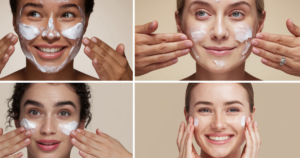Do you struggle with dry, flaky, or irritated skin? You’re not alone! Maintaining hydrated skin can feel like an uphill battle, especially during colder months when indoor air is dry, and the natural moisture of the skin evaporates more rapidly. The solution? Moisturizers. These skincare products play a vital role in keeping the skin hydrated and healthy. But have you ever wondered how moisturizer work? Let’s dive into the science behind moisturizers and understand their mechanisms.
The Job of Moisturizers: More Than Just Hydration
Moisturizers are skincare heroes designed to keep your skin hydrated and happy. how moisturizer work by combating a process called transepidermal water loss (TEWL)—when water evaporates from your skin’s surface. By either locking in or adding moisture, moisturizers protect your skin’s natural barrier and keep it smooth, soft, and glowing.
But that’s not all! Moisturizers also shield your skin from harsh weather, pollution, and other environmental factors that can strip away its natural oils. Think of them as your skin’s protective armor.
Understanding the Skin’s Barrier
The outermost layer of the skin, the stratum corneum, acts as the body’s barrier to the outside world. It consists of dead cells called corneocytes embedded in a matrix of lipids (fats). This “brick and mortar” structure is crucial for maintaining the skin’s water balance. For the skin to feel smooth and supple, the stratum corneum must contain at least 10% water, with an optimal range of 20-30%.
When the stratum corneum loses water, it becomes dry, flaky, and cracked. Moisturizers address this issue by either preventing water loss, adding moisture, or enhancing the skin’s ability to retain water.
Types of Ingredients in Moisturizers
Modern how moisturizers work combine several types of ingredients to achieve their effects. Here are the primary components:
1. Occlusives
Occlusives form a barrier on the skin’s surface, preventing water from evaporating. Petrolatum (found in Vaseline) is one of the most effective occlusive agents, reducing TEWL by nearly 99%. Other common occlusives include:
- Mineral oil
- Dimethicone
- Lanolin
- Petrolatum (used in Vaseline)
- Vegetable oils like coconut or olive oil
2. Humectants
Humectants attract water from the environment and deeper layers of the skin into the stratum corneum. Common humectants include:
- Glycerin
- Hyaluronic acid
- Urea
- Lactic acid
- Sorbitol
While humectants help hydrate the skin, they are often paired with occlusives to prevent water drawn to the surface from evaporating.
3. Emollients
Emollients fill the gaps between skin cells, smoothing and softening the skin. Many occlusives and humectants also serve as emollients. Examples include:
- Fatty alcohols (cetyl alcohol)
- Silicones (dimethicone)
- Plant oils (shea butter, jojoba oil)
4. Vitamins and Active Ingredients
Some moisturizers contain vitamins and active ingredients for additional benefits:
- Vitamin A (retinoids): Promote collagen production and reduce wrinkles.
- Vitamin C and E: Offer antioxidant protection, though their efficacy depends on concentration and stability.
- Lactic acid and urea: Enhance skin hydration and improve barrier function.
How Moisturizers Work Together
How moisturizers work often combine these ingredients to provide comprehensive care. For example:
- Occlusives lock in moisture, preventing evaporation.
- Humectants draw water into the skin.
- Emollients smooth the skin surface.
| Season | Skin Challenges | Moisturizer Functions | Recommended Ingredients | Tips for Use |
|---|---|---|---|---|
| Summer | – Increased sweating – Oily skin due to heat – Sun exposure – Dehydration from heat | – Lightweight hydration – Oil control – Sun protection – Cooling and soothing | – Hyaluronic acid – Aloe vera – Non-comedogenic ingredients – SPF-enriched formulations | – Use gel-based or water-based moisturizers – Apply sunscreen daily – Reapply after sweating or swimming |
| Winter | – Dryness and flakiness – Harsh winds – Dehydration from indoor heating | – Intensive hydration – Locking in moisture – Protecting the skin barrier | – Ceramides – Shea butter – Petrolatum – Glycerin – Lanolin | – Use thicker creams – Apply right after bathing – Reapply during the day if skin feels tight or dry |
| Spring/Fall | – Transitional weather causing skin imbalance – Potential allergies (spring) – Mild dryness | – Balanced hydration – Soothing and calming irritated skin – Adapting to changing weather conditions | – Niacinamide -jojoba oil – Light emollients – Vitamin E | – Use lightweight creams or lotions – Patch-test products during allergy season – Hydrate twice daily |
| Year-Round | – Pollution and environmental stress – Skin type-specific concerns | – Consistent hydration – Supporting skin’s barrier function – Targeting specific skin concerns | – Antioxidants (Vitamin C & E) – Peptides – Non-irritating formulas tailored to skin type | – Adjust routine seasonally – Prioritize non-comedogenic and hypoallergenic products for sensitive skin |
Choosing the Right Moisturizer for Your Skin Type
The effectiveness of a moisturizer depends on your skin type:
- Dry Skin: Use thick creams with occlusives like petrolatum and humectants like glycerin.
- Oily Skin: Opt for lightweight, oil-free moisturizers with hydrating ingredients like hyaluronic acid.
- Combination Skin: Choose a balanced product with both humectants and emollients.
- Sensitive Skin: Look for fragrance-free, hypoallergenic products with soothing ingredients like aloe vera.
Choosing the Right Moisturizer for Your Skin Type
- Apply right after cleansing: Damp skin helps lock in more moisture.
- Layer at night: Use a thicker layer for deeper hydration while you sleep.
- Don’t skip sunscreen: During the day, pair your moisturizer with SPF to protect against UV damage.
- Be gentle with exfoliation: Over-exfoliating can strip your skin’s natural oils, making moisturizers less effective.
Moisturizers are essential for healthy, glowing skin. By understanding how they work and choosing the right product for your needs, you can transform your skincare routine and enjoy the benefits of hydrated, radiant skin every day. So go ahead—apply that moisturizer and let your skin shine!




